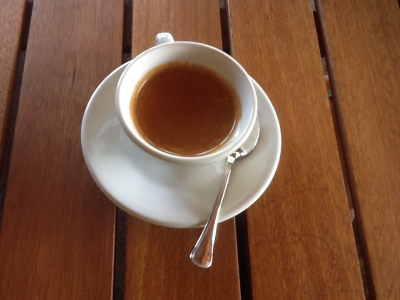It’s an espresso
Are you sure that you can discern the true quality of a cup of coffee? When it is good, it should be sipped slowly and peacefully. Espresso coffee, the quintessential Italian beverage, should be savoured unsweetened, so as to fully appreciate its aroma.

First of all, the golden rule: a cup of espresso coffee should always be savoured plain. No sweeteners should be added, because they change the natural sensory profile of the product, killing much of its true aroma.
Flawless raw material, and not a stroke of luck, is behind an excellent espresso coffee. A cup of the beverage contains about seven grams of coffee, roughly corresponding to 50 beans. One tarnished bean alone can ruin the overall flavour of your drink.
Quality is often difficult to achieve, because it depends on a variety of factors:
– The plant species, usually arabica or robusta, but others too can be used. Arabica yields the best coffee.
-Agronomical factors. Good farming conditions have a considerable effect on the quality of the beans.
– Environmental conditions. Given that the plant is a living being, it is always affected by the weather.
– The harvesting methods. Windfalls fail to give a good end product; if the coffee cherries are simply stripped from the plants, without distinguishing between ripe and unripe fruit, the end product will be uneven; if on the other hand only the red cherries are hand-picked, while the unripe and brown ones are discarded, the end product will be of a much higher quality.
– How the beans are processed. Sun-dried beans are better than those subjected to mechanical processes.
– Storage method. Storing greatly affects quality. Ideally, the coffee beans should be kept in well-aired rooms, away from direct sunlight.
– Blending is a critical stage, because the features of the various beans employed must be combined so as to improve the quality of the beverage. The traits of the blend should not change in time, preserving an intense and persistent, but not excessive, aroma and a taste that is a perfect balance of bitterness, acidity and sweetness. The beans can be blended either before or after roasting.
– The roasting stage: the beans should first be screened, discarding all defective ones (unripe, fermented, broken, not perfectly hulled, etc.), by means of optic sorting equipment that can scan up to 200 beans per second. Roasting is another crucial stage because it modifies the internal structure of the bean: the cell walls break down and new chemical compounds develop.
– The packaging and storing of the roasted beans. In recent years, many steps forward have been taken, and currently, the best technique employed for packaging the coffee beans is by pressurization, a system devised by Francesco Illy that traps all essential aromas and protects them for long periods of time.
– The degree of grinding and the shelf life of coffee.
– How the coffee is brewed. First of all, it is essential to percolate the coffee for the correct length of time, otherwise the quality of the beverage will decrease. Another essential factor is the brewing method: espresso percolation is considered the best, because it extracts the majority of the aromatic compounds present in the bean without altering them. Finally, the type of machine employed and its efficiency play a major role in determining the quality of the end product.
– The cleaning and maintenance of the espresso machine.
– The experience of the coffee brewer, and the care put into the process.
KEEPING AN EYE ON QUALITY
Below is the typical sensory profile of a cup of good espresso coffee. This is only a reference profile, but contains all the features to look out for.
– The crema, i.e. the creamy froth on top, has a good texture, rich and dense, and does not contain any air bubbles or white dots; it has a long lasting, thick consistency, and a hazel to dark brown colour.
– The aroma is rich and varied, fine, clean and persistent, with balanced notes of toasted bread, flowers and chocolate.
– The taste is fine and velvet-like, round and elegant, with a pleasant balance of sour and bitter flavours.
– Finally, the retro-nasal perception of flavours is clear, with a pleasant return of flowery and chocolate notes, as well as other traits.
Nothing can be left to chance. A cup of good espresso coffee requires thirty seconds of percolation time with entry water at about 90°C and 9 bar pressure.
Nowadays it is possible to prepare a satisfactory cup of espresso coffee without being an expert, by using coffee pods containing the right amount of ground and pressed coffee. The resulting beverage is not only full bodied, tasty and aromatic, but also healthy, since it contains a level of caffeine that makes the drink both stimulating and relaxing.
Picture by Luigi Caricato
To comment you have to register
If you're already registered you can click here to access your account
or click here to create a new account


Comment this news